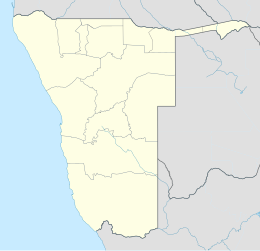The Battle of Ongulumbashe (also known as Operation Blouwildebees) was an armed confrontation between the South African Defence Force (SADF)/ South African Police (SAP) and the South West African People's Organization (SWAPO) at Ongulumbashe in northern South West Africa (today Namibia). Though SWAPO had already carried out several attacks in 1965 and early 1966, the battle marked the first time that elements of the South African security forces directly clashed with SWAPO insurgents and is considered to be the start of the South African Border War.[1]: 44
| Battle of Ongulumbashe | |||||||
|---|---|---|---|---|---|---|---|
| Part of the South African Border War | |||||||
| |||||||
| Belligerents | |||||||
|
|
| ||||||
| Commanders and leaders | |||||||
|
| Unknown | ||||||
| Units involved | |||||||
|
|
| ||||||
| Strength | |||||||
|
42 paratroops and police 7 Alouette III helicopters | 17 Insurgents | ||||||
| Casualties and losses | |||||||
| None |
2 killed 1 wounded 8 captured | ||||||
Background
editIn 1962, the UN General Assembly adopted the position that South Africa's mandate over South West Africa (in force since the end of World War I) should be terminated and that the territory should be given independence.[2]: 24 South Africa, at this time under the rule of the Apartheid regime, refused to recognize this decision and no substantial moves towards independence for the territory were made. The inaction of the South African's emboldened SWAPO, who had been preparing for an armed struggle against the South African authorities in South West Africa since the early 1960s.[2]: 24
SWAPO Infiltration and South African Response
editIn September 1965, the first group of SWAPO insurgents (numbering only about seven men) moved across the thinly guarded Angola/SWA border and began attacking targets in northern South West Africa. These included a local administrative building, a local tribal headman suspected to be in the employ of the South Africans, and a Portuguese shop owner.[1]: 42 SWAPO established a camp at Ongulumbashe (modern spelling: Omugulugwombashe) from which further operations could be conducted. Incidentally, this was the only semi-permanent camp established by SWAPO on South West African soil for the duration of the conflict.[2]: 25 SWAPO's presence in the region soon expanded until the total number of active insurgents numbered about 17.
By early 1966, the South African authorities had become aware of SWAPO's presence and two Alouette III helicopters were dispatched to the region to aid the detachment of South African police assigned to guard the border. Using an informer within the group of insurgents, the South Africans were able to pinpoint the location of the SWAPO guerillas to Ongulumbashe. To dislodge the guerillas, the South Africans devised Operation Blouwildebees, the first ever heliborne assault undertaken by the South African armed forces.[1]: 43
Battle
editOn the 26th of August 1966, seven Alouette III helicopters, each carrying a six man assault team, took off from Ruacana and flew north towards Ongulumbashe. The helicopters deposited the combined force of South African police and paratroops at pre-determined locations around the camp. A gun-battle ensued between the insurgents, entrenched around the camp, and the security forces. The South Africans quickly overpowered the insurgents at the camp, killing 1, wounding 1, and capturing 8. A short follow-up operation was then launched in which another insurgent was killed. At least 2 insurgents were known to have escaped the battle.[1]: 45
Aftermath
editDespite the South African's success, the battle did not immediately stop SWAPO activities in Ovamboland. From the remainder of 1966 and into 1967, SWAPO would carry out a number of attacks, including arson and the murder of tribal headmen. However, by September 1967 8 insurgents had been killed and 59 captured. These losses effectively curtailed SWAPO operations in Ovamboland until the early 1970s but small scale SWAPO attacks and infiltrations did take place.[2]: 27
References
editBibliography
edit- Lord, Dick (2008). From Fledgling to Eagle. The South African Airforce During the Border War. 30 South Publishers (Pty) Ltd. ISBN 978-1-928359-07-4.
- Steenkamp, Willem (2016). South Africa's Border War 1966–1989. Tafelberg. ISBN 978-0-624-07690-2.
